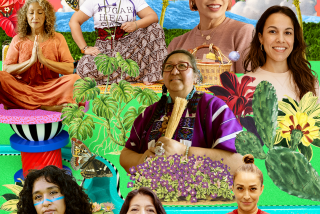Surgeon Operates in 2 Worlds
- Share via
SANTA FE, N.M. — Lori Arviso Alvord is a doctor, but she can still see herself as a little Navajo girl playing on a remote, dusty mesa.
She is a surgeon who uses the most advanced technology, yet she has sought help from a medicine man.
She is a modern-day teacher and administrator, firmly rooted in the traditional philosophy of balance and harmony her tribe calls “Walking in Beauty.”
Alvord has spent her entire life straddling two worlds, an experience summed up in the title of her just-released book, “The Scalpel and the Silver Bear,” published by Bantam Books.
“It’s important to bring Navajo philosophy, which I think is incredibly valuable and not well understood . . . to the larger world,” said Alvord, the first female Navajo surgeon.
And to the world of medicine, especially. Modern doctors, she says, must find their way back to being healers.
“I am definitely . . . on a mission to change the way health care is delivered,” said Alvord, interviewed recently as she wrapped up a weeklong book tour that included Gallup, Albuquerque and Santa Fe.
The New Mexico stops brought her home again. She grew up in Crownpoint, a small Navajo community near the edge of the reservation, and practiced medicine for six years, until 1997, at Gallup Indian Medical Center.
She now works at Dartmouth Medical School in New Hampshire, where she is the associate dean of minority and student affairs and a general surgeon at Dartmouth-Hitchcock Medical Center.
Alvord, her husband, and their two young children live on a green hillside overlooking a lake, with plenty of sky in sight.
But her attachment to the vast, high, red-rock country that is her home remains powerful.
“It’s hard to be away,” she said. “I cried as I walked through the Albuquerque airport.”
For many years, Alvord has worn around her neck a small silver bear that is a constant reminder of her Navajo culture. Bears are sacred to the tribe and are associated with her family’s clan. The bear’s spirit gives her courage and strength, she says.
Born to a white mother and a Navajo father, Alvord, 40, says she was encouraged as a youngster to read and to dream. She went to high school at Crownpoint, college at Dartmouth and medical school at Stanford.
She has long believed that a higher power operates her life, opening doors that she’s supposed to walk through.
“I didn’t plan to go to an Ivy League school and get a degree. I didn’t plan to be a physician . . . to be a surgeon . . . to be an author. It just sort of happened,” Alvord said.
She was working after college in a laboratory at the University of New Mexico when she decided to try to overcome her fear of the sciences and take premed classes.
“She was certainly smart enough to do just about anything she wanted,” said Dr. Gary Rosenberg, whom Alvord credits with encouraging her to become a doctor.
“She’s an exceptional person, with her . . . intensity and her ability to get what she wants,” said Rosenberg, now chairman of the neurology department at UNM’s medical school.
As Alvord practiced Western medicine at the Gallup hospital, she realized her Navajo surgical patients needed more than her technical ability and clinical skills. If they were to heal, they needed to be treated sensitively and respectfully, and be provided with a calm and serene atmosphere during their surgeries.
Her book, written with journalist Elizabeth Cohen Van Pelt, describes how she gradually incorporated into her practice elements of the fundamental Navajo belief of “Walking in Beauty,” a world view in which everything is connected.
Navajos strive to live in harmony and balance with everyone and everything else, and they see sickness as a result of things falling out of balance, she said.
To medicine men--one of whom Alvord consulted when she was pregnant--patients are not seen as just bodies, but as whole beings.
Alvord wants medical students to understand that “everything matters when it comes to looking at a patient--not just a physical ailment, but whether a patient is in harmony or out of harmony with the rest of their world,” she said.
Dr. Susan Stuart, a fellow surgeon at Gallup Indian Medical Center who became a close friend, said Alvord was warm, caring and willing to listen to her patients.
“Surgeons have a tendency to focus on the acute problem, and not focus on the whole person. She managed to do that and set an excellent example for others to remember to do that,” Stuart said.
People who are sick in the Navajo world may be the focus of ceremonies that last up to seven days. Their entire families and communities mobilize around them, providing support.
“Nothing like that exists in Western medicine, that I know of, to make a person well,” Alvord said. “I would actually like to see elements of ceremony brought into Western medicine for non-Indian patients, because I think they’re craving it.”
Alvord readily acknowledges that her ideas run contrary to the time pressures of managed care. But such concepts deserve to be discussed, she said.
“We need to sit back and look again at how our health care system is set up and decide for ourselves . . . is that the best we could do?”
More to Read
Sign up for Essential California
The most important California stories and recommendations in your inbox every morning.
You may occasionally receive promotional content from the Los Angeles Times.













